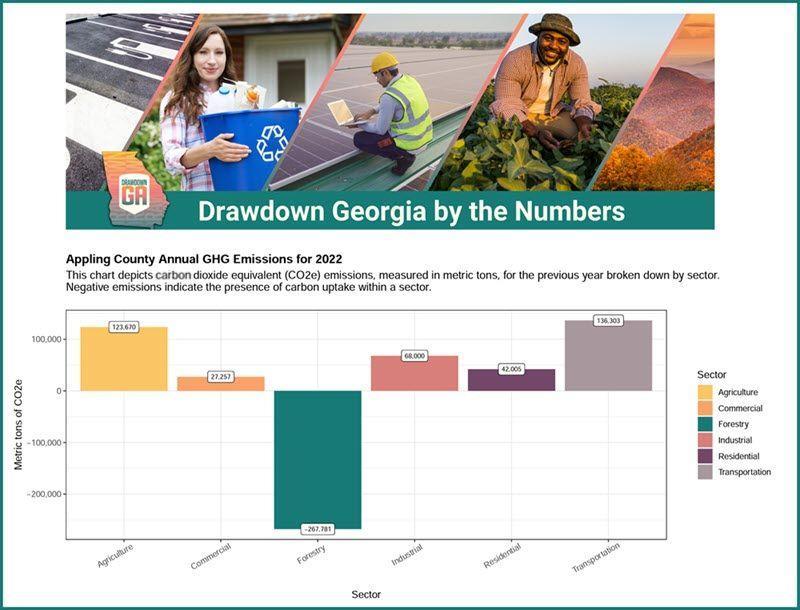Georgia’s Changing Carbon Footprint
Drawdown Georgia reports on progress and opportunities
Published 05-15-23
Submitted by Ray C. Anderson Foundation

Contact:
Lisa Lilienthal, 404-661-3679
lisa@dialogue.marketing
ATEHNS, Ga., May 15, 2023 /CSRwire/ - Georgia’s overall greenhouse gas emissions are declining, experts and researchers from the Drawdown Georgia Research Team announced. The researchers report that, while the Covid-19 pandemic may have been the impetus for some of the emission decline measured from 2017 to 2021, most emission reductions come from the use of cleaner fuels to generate electricity in the state. Researchers also posit that the opportunity to more quickly deploy Georgia’s most effective climate solutions is supported by investments that are newly available under recent federal policy, such as the Inflation Reduction Act.
“Despite strong economic and population growth, Georgia’s GHG emissions declined by 5% between 2017 and 2021,” said Dr. Marilyn A. Brown, Regents' Professor and Brook Byers Professor of Sustainable Systems in the School of Public Policy at Georgia Tech. “While some numbers are trending in the right direction, our data analysis also tells us that segments of our economy have an expanding carbon footprint. This helps us understand how to focus climate solutions work in Georgia where it is most needed.”
“The Drawdown Georgia Research Team reports that the Georgia story is beginning to trend to a positive one, and that the carbon footprint of our “average” citizen has declined from 22,092 to 20,253 pounds,” said John Lanier, executive director of the Ray C. Anderson Foundation, a primary funder of Drawdown Georgia. “That’s an 8% decline. Based on the collaborations we’re a part of, we’re confident this is only the beginning of Georgia’s carbon reduction trend.”
Drawdown Georgia is a statewide research-based initiative launched in 2020 that was born from a multi-university collaboration, localizing the climate solutions work done by Project Drawdown to identify the 20 highest impact solutions for reducing greenhouse gas emissions in the state in five sectors: Electricity, Transportation, Land Sinks, Food and Agriculture, and Buildings and Materials. The organization tracks these metrics through its one-of-a-kind Greenhouse Gas Emissions Tracker.

Exploring Emissions in Georgia by Sector
Electricity Sector
“The Electricity sector has offered the greatest opportunity for emissions reduction, historically, and can also be a big source of emissions” said Dr. Brown. “And, the numbers are different for residential and commercial consumers.”
- Carbon emissions from Georgia’s electric power plants declined by more than 15% between 2017 and 2021. This was primarily driven by the retirement of coal plants, the shift to natural gas, and large-scale solar. These trends were supported by the increasing efficiency of our homes and businesses.
- The reduction in emissions has varied across end users. The residential sector has the largest demand for electricity, and home heating in Georgia depends primarily on natural gas. In contrast, commercial buildings almost exclusively depend on electricity, so the carbon footprint of offices and businesses has decreased as the power sector has cleaned up. Offices have also been dialing back in occupancy levels due to Covid, and as a result, office buildings have seen a larger decline in GHG emissions compared to homes, apartment complexes, and industry.
Land Sinks
The “steady state” contributor that has kept Georgia’s carbon footprint in check has been its natural carbon sinks, called “land sinks” by the Drawdown Georgia team. Over the four year period, Georgia's forests, soil, and wood products provided a reliable and significant offset to some of the state’s carbon emissions.
“Georgia’s forests and soils, which absorb carbon dioxide, offset nearly a third of Georgia’s emissions,” said Dr. Brown. “And an even more positive story can be told by the state’s wood products that offer an expanding carbon sink.”
- Georgia’s carbon sinks overall declined by only 1.6% between 2017 and 2021: while forest carbon uptake decreased by 2.9%, the carbon stored in wood products increased by 3.5%.
Transportation
“The decarbonization of electricity has moved Transportation into the driver’s seat as Georgia's largest source of carbon emissions,” said Dr. Brown. “And while emissions from commuters declined during the pandemic, emissions from diesel-fueled medium and heavy-duty trucks grew due to increased deliveries during Covid.”
- Transportation emissions surpassed pre-pandemic (2017) levels in 2021, emitting nearly 60 million metric tons of carbon dioxide (MMtCO2) in 2021, 4% more than its 57.3 MMtCO2 in 2017.
- While gasoline-powered cars, pick-ups, and SUVs returned to pre-COVID levels, emissions from diesel-fueled medium and heavy-duty trucks and buses grew by 16.1%. This was driven by a boom in online retailing, accounting for nearly all of the sector's growth in emissions.

Food and Agriculture
Carbon emissions from food and agriculture decreased by 7.1% from 10.1 in 2017 to 9.4 million tonnes in 2021.
- Agriculture soil management and electricity used in the agriculture industry are large contributors to the sector's emissions and are also the main driver of the sector's emission reduction, followed by the decline in GHG emissions from electricity.
- Manure management was the only sub-sector that increased its emissions (5.9%).
Drawdown Georgia by the Numbers Updates Available
County-level quarterly emissions updates are now available from Drawdown Georgia. You can also find state- and county-level emissions data on the Drawdown Georgia GHG Emissions Tracker, a one-of-its-kind dashboard and tool that aggregates information from monthly data published by the U.S. Department of Energy’s Energy Information Administration and the U.S. Department of Transportation, as well as from annual data published in the State Inventory Tool and FLIGHT large facility emissions database, both created by the U.S. Environmental Protection Agency. The GHG Tracker was created by a team of data scientists led by Dr. William Drummond at Georgia Tech to aid municipal and elected officials, climate scientists, researchers, and advocates to better understand trends in emissions at a local level in Georgia.

About Drawdown Georgia
Drawdown Georgia is a statewide research-based initiative launched in 2020 that was born from a multi-university collaboration, funded by the Ray C. Anderson Foundation. Taking inspiration from Project Drawdown®, the world’s leading resource for taking action on climate change, Drawdown Georgia localized that work by identifying the 20 highest-impact solutions for reducing greenhouse gas emissions in our state over the next decade.
This framework focuses on climate solutions in five sectors: transportation, buildings & materials, food & agriculture, electricity, and land sinks. It considers how these solutions can reduce emissions and advance “beyond carbon” priorities, including equity, economic development, public health, and nurturing the larger environment.
Drawdown Georgia has grown into a “leader-full” movement, bringing together many organizations, universities, companies, leaders, and funders who are working to advance climate solutions in Georgia, including members of the Drawdown Georgia Business Compact, Drawdown Congregations, and Drawdown Higher Education. Learn more at drawdownga.org.

Ray C. Anderson Foundation
Ray C. Anderson Foundation
The Ray C. Anderson Foundation was created in honor of the late Ray C. Anderson (1934-2011), founder of Interface, Inc. During his time at Interface, Ray championed the notion of businesses doing well by doing good. It’s these noble qualities of advancing knowledge and innovation around environmental stewardship and sustainability that recognized Ray as a pioneer in industrial ecology.
The purpose of the Foundation is to perpetuate these shared values and continue the legacy that Ray left behind. Through research and funding, the Foundation aims to help create a better world for future generations—tomorrow’s child. Join us as the story of the Foundation continues to unfold.
More from Ray C. Anderson Foundation

